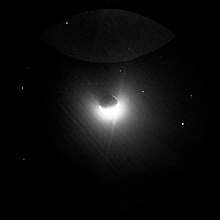Geocorona
The geocorona is the luminous part of the outermost region of the Earth's atmosphere, the exosphere. It is seen primarily via far-ultraviolet light (Lyman-alpha) from the Sun that is scattered from neutral hydrogen.[1] It extends to at least 15.5 Earth radii and probably up to about 100 Earth radii.[2] The geocorona has been studied from outer space by the Astrid satellites and the Galileo spacecraft (among others), using its ultraviolet spectrometer (UVS) during an Earth flyby.

The Earth and its hydrogen envelope, or geocorona, as seen from the Moon. This ultraviolet picture was taken in 1972 with a camera operated by Apollo 16 astronauts on the Moon.
See also
References
- Kameda, S.; Ikezawa, S.; Sato, M.; Kuwabara, M.; Osada, N.; Murakami, G.; Yoshioka, K.; Yoshikawa, I.; Taguchi, M.; Funase, R.; Sugita, S.; Miyoshi, Y.; Fujimoto, M. (16 December 2017). "Ecliptic North-South Symmetry of Hydrogen Geocorona". Geophysical Research Letters. 44 (23): 11, 706–11, 712. doi:10.1002/2017GL075915.
- Baliukin, I. I.; Bertaux, J.-L.; Quémerais, E.; Izmodenov, V. V.; Schmidt, W. (15 February 2019). "SWAN/SOHO Lyman‐α mapping: the Hydrogen Geocorona Extends Well Beyond The Moon". Journal of Geophysical Research: Space Physics. doi:10.1029/2018JA026136.
This article is issued from Wikipedia. The text is licensed under Creative Commons - Attribution - Sharealike. Additional terms may apply for the media files.